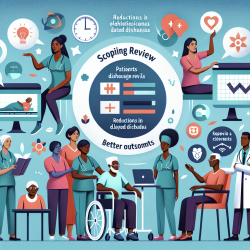Embracing the Future: The Power of Pediatric Telerehabilitation
The landscape of pediatric therapy has been forever altered by the advent of telerehabilitation, a service delivery model that has proven to be both feasible and acceptable in clinical settings. According to the research article "Feasibility and Acceptability of Clinical Pediatric Telerehabilitation Services," telerehabilitation has become a vital tool in maintaining continuity of care, especially during the COVID-19 pandemic. This blog explores how practitioners can harness the findings of this study to enhance their practice and improve outcomes for children.
Understanding the Research
The study conducted by Tanner et al. (2020) investigated the feasibility and acceptability of telerehabilitation services in a pediatric hospital setting. The research demonstrated that patient satisfaction remained high (97.73%) even when services transitioned from in-person to telerehabilitation. This finding is crucial as it underscores the potential of telerehabilitation to deliver effective care while overcoming barriers such as geographical constraints and social distancing requirements.
Key Takeaways for Practitioners
As practitioners, it is essential to integrate data-driven insights into our practice. Here are some strategies to consider based on the study's outcomes:
- Leverage Technology: Ensure that your practice is equipped with reliable technology platforms like secure video conferencing tools. This will facilitate seamless communication and interaction with patients and their families.
- Enhance Communication: Clear and consistent communication with caregivers is vital. Provide detailed instructions on accessing telerehabilitation services and address any technological concerns they may have.
- Focus on Education: Educate both staff and families about the benefits and procedures of telerehabilitation. Utilize webinars and other resources to ensure everyone is comfortable and confident in this service delivery model.
- Expand Services: Consider integrating telerehabilitation as a complementary service alongside in-person visits. This hybrid model can cater to diverse patient needs and preferences.
Encouraging Further Research
While the study provides a robust foundation, there is a need for ongoing research to explore the long-term impacts of telerehabilitation on patient outcomes. Practitioners are encouraged to contribute to this growing body of knowledge by conducting their own studies and sharing findings with the broader community. Collaborative efforts can lead to innovative solutions and improved care strategies.
Conclusion
The shift towards telerehabilitation represents a significant opportunity for practitioners to enhance access to care and improve outcomes for children. By embracing technology, prioritizing communication, and fostering a culture of continuous learning, we can ensure that telerehabilitation becomes an integral part of pediatric therapy. To read the original research paper, please follow this link: Feasibility and Acceptability of Clinical Pediatric Telerehabilitation Services.










